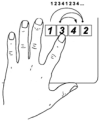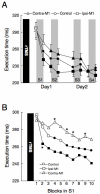Suppression of ipsilateral motor cortex facilitates motor skill learning
- PMID: 19200062
- PMCID: PMC2771229
- DOI: 10.1111/j.1460-9568.2009.06628.x
Suppression of ipsilateral motor cortex facilitates motor skill learning
Abstract
The primary motor cortex (M1) plays a critical role in early aspects of motor skill learning. Given the notion of inter-hemispheric competition, unilateral disruption of M1 may increase excitability of the unaffected motor cortex and thus improve motor learning with the ipsilateral hand. We applied slow-frequency repetitive transcranial magnetic stimulation (rTMS) before the initiation of practice of a simple motor skill. Participants were randomly divided into three stimulation groups: (i) ipsilateral M1; (ii) contralateral M1; and (iii) Cz (control site). The mean execution time and error rate were recorded in four sessions distributed over 2 days. Disruption of M1 with rTMS slowed down skill acquisition with the contralateral hand, albeit non significantly, but paradoxically enhanced learning with the ipsilateral hand. This was evidenced by a significant decrease of execution time at the end of day 1 in the group that received rTMS over the ipsilateral M1 compared with both control groups (Cz and contralateral M1 stimulation). This supports the notion of inter-hemispheric competition and provides novel insights that may be applicable to neurorehabilitation.
Figures


Similar articles
-
Effect of slow repetitive TMS of the motor cortex on ipsilateral sequential simple finger movements and motor skill learning.Restor Neurol Neurosci. 2010;28(4):437-48. doi: 10.3233/RNN-2010-0562. Restor Neurol Neurosci. 2010. PMID: 20714068
-
Cooperation Not Competition: Bihemispheric tDCS and fMRI Show Role for Ipsilateral Hemisphere in Motor Learning.J Neurosci. 2017 Aug 2;37(31):7500-7512. doi: 10.1523/JNEUROSCI.3414-16.2017. Epub 2017 Jul 3. J Neurosci. 2017. PMID: 28674174 Free PMC article.
-
Repetitive TMS of the motor cortex improves ipsilateral sequential simple finger movements.Neurology. 2004 Jan 13;62(1):91-8. doi: 10.1212/wnl.62.1.91. Neurology. 2004. PMID: 14718704 Clinical Trial.
-
Hemispheric asymmetry of ipsilateral motor cortex activation in motor skill learning.Neuroreport. 2013 Sep 11;24(13):693-7. doi: 10.1097/WNR.0b013e3283630158. Neuroreport. 2013. PMID: 23924953
-
M1 contributes to the intrinsic but not the extrinsic components of motor-skills.Cortex. 2009 Oct;45(9):1058-64. doi: 10.1016/j.cortex.2009.01.003. Epub 2009 Feb 5. Cortex. 2009. PMID: 19243742
Cited by
-
Probing for hemispheric specialization for motor skill learning: a transcranial direct current stimulation study.J Neurophysiol. 2011 Aug;106(2):652-61. doi: 10.1152/jn.00210.2011. Epub 2011 May 25. J Neurophysiol. 2011. PMID: 21613597 Free PMC article.
-
Polarity specific effects of transcranial direct current stimulation on interhemispheric inhibition.PLoS One. 2014 Dec 5;9(12):e114244. doi: 10.1371/journal.pone.0114244. eCollection 2014. PLoS One. 2014. PMID: 25478912 Free PMC article.
-
Role of Single Low Pulse Intensity of Transcranial Magnetic Stimulation Over the Frontal Cortex for Cognitive Function.Front Hum Neurosci. 2020 Jul 3;14:205. doi: 10.3389/fnhum.2020.00205. eCollection 2020. Front Hum Neurosci. 2020. PMID: 32719592 Free PMC article.
-
Weaker Inter-hemispheric and Local Functional Connectivity of the Somatomotor Cortex During a Motor Skill Acquisition Is Associated With Better Learning.Front Neurol. 2019 Nov 27;10:1242. doi: 10.3389/fneur.2019.01242. eCollection 2019. Front Neurol. 2019. PMID: 31827459 Free PMC article.
-
Using repetitive transcranial magnetic stimulation to study the underlying neural mechanisms of human motor learning and memory.J Physiol. 2011 Jan 1;589(Pt 1):21-8. doi: 10.1113/jphysiol.2010.198077. Epub 2010 Nov 1. J Physiol. 2011. PMID: 21041531 Free PMC article.
References
-
- Antal A, Nitsche MA, Kincses TZ, Kruse W, Hoffmann KP, Paulus W. Facilitation of visuo-motor learning by transcranial direct current stimulation of the motor and extrastriate visual areas in humans. Eur. J. Neurosci. 2004;19:2888–2892. - PubMed
-
- Baraduc P, Lang N, Rothwell JC, Wolpert DM. Consolidation of dynamic motor learning is not disrupted by rTMS of primary motor cortex. Curr. Biol. 2004;14:252–256. - PubMed
-
- Bestmann S, Baudewig J, Siebner HR, Rothwell JC, Frahm J. Subthreshold high-frequency TMS of human primary motor cortex modulates interconnected frontal motor areas as detected by interleaved fMRI-TMS. Neuroimage. 2003;20:1685–1696. - PubMed
-
- Brashers-Krug T, Shadmehr R, Bizzi E. Consolidation in human motor memory. Nature. 1996;382:252–255. - PubMed
Publication types
MeSH terms
Grants and funding
LinkOut - more resources
Full Text Sources

